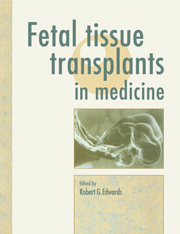Book contents
- Frontmatter
- Contents
- List of contributors
- Preface
- 1 Differentiation and transplantation of embryonic cells in mammals
- 2 Organogenesis and central nervous system development
- 3 Experimental human hematopoiesis in immunodeficient SCID mice engrafted with fetal blood-forming organs
- 4 Ontogeny of human T- and B-cell immunity
- 5 The procurement of human fetal tissues for clinical transplantation. Practice and problems
- 6 Transplantation of fetal haemopoietic and lymphopoietic cells in humans, with special reference to in utero transplantation
- 7 The biology of fetal brain tissue grafts: from mouse to man
- 8 Clinical results of transplanting fetal pancreas
- 9 The suitability of fetal and infantile donors for corneal transplantation
- 10 Transplantation of ovaries and testes
- 11 Cell grafting and gene therapy in metabolic diseases
- 12 The low temperature preservation of fetal cells
- 13 Law and ethics of transplanting fetal tissue
- Appendix: Code of practice on the use of fetuses and fetal material in research and treatment
- Brief bibliography on various aspects of transplanting fetal 337 tissue
- Index
1 - Differentiation and transplantation of embryonic cells in mammals
- Frontmatter
- Contents
- List of contributors
- Preface
- 1 Differentiation and transplantation of embryonic cells in mammals
- 2 Organogenesis and central nervous system development
- 3 Experimental human hematopoiesis in immunodeficient SCID mice engrafted with fetal blood-forming organs
- 4 Ontogeny of human T- and B-cell immunity
- 5 The procurement of human fetal tissues for clinical transplantation. Practice and problems
- 6 Transplantation of fetal haemopoietic and lymphopoietic cells in humans, with special reference to in utero transplantation
- 7 The biology of fetal brain tissue grafts: from mouse to man
- 8 Clinical results of transplanting fetal pancreas
- 9 The suitability of fetal and infantile donors for corneal transplantation
- 10 Transplantation of ovaries and testes
- 11 Cell grafting and gene therapy in metabolic diseases
- 12 The low temperature preservation of fetal cells
- 13 Law and ethics of transplanting fetal tissue
- Appendix: Code of practice on the use of fetuses and fetal material in research and treatment
- Brief bibliography on various aspects of transplanting fetal 337 tissue
- Index
Summary
MANY INSIGHTS ON REGENERATION by grafting fetal and adult tissue into recipients can be gained by studying the differentiation and formation of the embryo. This chapter will relate work on grafting embryonic cells to knowledge on early mammalian embryology, and especially the regulatory factors involved in tissue formation. It is not intended to be a comprehensive analysis of early embryology, and cited references to books and review should be consulted for this purpose. References to work on amphibians and insects will be made where necessary. The differentiation of the human embryo to approximately day 20 will be considered to be the end of the embryonic phase when the primary organ systems have been established.
Embryonic differentiation to the blastocyst
Formation of the blastocyst
The initial stages of embryonic growth involve a cascade of regulatory events. After sperm entry into the oocyte, the sperm chromatin forms when disulphide bonds are cleaved and nuclear proteins degraded as histones from the oocyte replace the protamines (Yanagimachi, 1988; Tesarik, 1992). Paternal and maternal pronuclei undergo DNA synthesis, the initiation of the S phase in the cell cycle being regulated by cytoplasmic factors in many species and probably in man (Laskey et al., 1989); the pronuclei persist for approximately fifteen hours in human eggs (Edwards, 1980).
The first cleavage results in two equal-sized blastomeres and one of these divides before the other; the right-angled orientation of their cleavage planes being an indication of the tight regulation of embryonic growth. Early embryos might release trophic factors, e.g. platelet activating factor (PAF) (O'Neill et al, 1989). Blastomeres of approximately equal size formed in successive cleavages are associated by microvilli; their cytoplasmic organelles differentiate; and compaction in 8-cell embryos heralds the formation of outer trophectoderm cells associated by desmosomes and tight junctions which enclose one or more inner cells. The human blastocyst initially has 32-64 cells at 4-5 days (Table 1.1), a blastocoelic cavity, an inner cell mass and large secretory-like cells adjacent to it (Figures 1.1- 1.4) (Edwards, 1980). In mice, the inner cell mass regulates the overlying polar trophectoderm which colonizes the mural trophectoderm lining the blastocoels.
- Type
- Chapter
- Information
- Fetal Tissue Transplants in Medicine , pp. 1 - 50Publisher: Cambridge University PressPrint publication year: 1992



